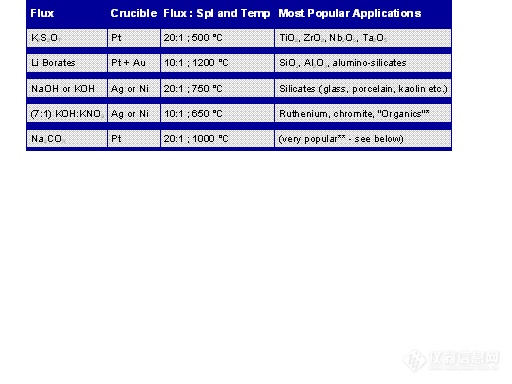


第1楼2005/03/31
Lithium Carbonate Fusions
Li2CO3 fusions are rarely mentioned in the literature. I am putting this method in the spotlight because:
Lithium salts are very soluble.
Lithium has relatively few spectral lines for the ICP-OES user.
Signal quenching (signal suppression by matrix) is relatively less (due to low mass) than the B, Na, or K containing fluxes for the ICP-MS user.
Lithium can be obtained in pure form as the carbonate and is relatively inexpensive.
Li2CO3 melts at relatively low temperatures (relative to the popular sodium carbonate fusion).
You can use graphite crucibles, which are both clean and inexpensive (I prefer glassy carbon which is more expensive, but very clean and not nearly as messy).
Li2CO3 is a basic fusion that will attack many of the refractory metal oxides and sample types attacked by Na2CO3.
CAUTION: Unlike Na2CO3, Li2CO3 will attack Pt crucibles
第2楼2005/03/31
Sample Preparation Procedure
The following method (developed in 1993 at Inorganic Ventures) can be used directly or as a stepping stone in the development of other methods.
Procedure Name:
"The Determination of Ca, Mg, Fe, Al, Mn and Si in Limestone" (Procedure No. 8-SPM-001)
Scope and Summary:
This procedure is intended for the determination of calcium, magnesium, manganese, iron, aluminum, and silicon in limestone. This procedure involves a fusion of the limestone with lithium carbonate at a sample to flux ratio of 1:4. The fusion is performed in a graphite crucible. The lifetime of the crucibles is between 10 and 12 fusions at 800 °C. This procedure was designed to be cost effective and fast in addition to giving accurate data.
Equipment:
Inductively Coupled Plasma Spectrometer equipped with an all glass / quartz introduction system and capable of determining the above elements at any wavelength in the 200-800 nm range.
Muffle furnace capable of 800 degrees Centigrade.
Graphite crucibles.
Analytical balances (2 and 4 place).
500 mL LDPE wide mouth bottles, cleaned by leaching with 5% (v/v) nitric acid for 48 hours.
50 mL graduated cylinder or dispenser.
Small glass rods / spatulas.
Crucible tongs and insulated gloves.
Vinyl or latex disposable gloves (dust free).
Disposable HDPE weighing dishes.
10, 5, and 1 mL adjustable mechanical pipettes with disposable tips. Calibrate with water before use.
Chemicals:
(All chemicals are available from Inorganic Ventures unless otherwise indicated)
10,000 礸/mL Ca and Mg standards.
1000 礸/mL Al, Fe, Mn, and Si (in NaOH) standards.
Lithium Carbonate - known purity that has been checked by ICP for above (6) analyte elements plus other elements if possible.
CMOS Grade concentrated Hydrochloric Acid (available from JT Baker).
High purity (12-18 Mω) water
Standard Preparation:
To each of two tarred 500 mL LDPE bottles, add ~200 mL of water plus 10 mL of concentrated hydrochloric acid.
Add 1.0 gram of lithium carbonate to each bottle and allow to dissolve.
To one of the bottles, add high purity water to a net weight of 500.0 grams. Label this as the Blank / Low Standard.
Using the calibrated mechanical pipettes, add the following to the remaining bottle:
- 10 mL of 10K Ca standard
- 2.5 mL of 10K Mg standard
- 2.5 mL of 1K Al standard
- 0.5 mL of 1K Mn standard
- 5 mL of 1K Si standard
- 2.5 mL of 1K Fe standard
It is suggested that the above additions be made by pipetting the standard aliquot into a tarred disposable HDPE weighing dish and record the weight. Compare the observed weight of the aliquot to the weight calculated using the density of the standard on the Certificate of Analysis.
Bring the net weight of this solution (High Standard) to 500.0 grams using high purity water. Mix well and label with respect to date and contents. This solution contains ~2 % (v/v) HCl, ~0.2 % lithium carbonate, 200 礸/g Ca, 50 礸/g Mg, 5 礸/g Al, 1 礸/g Mn, 10 礸/g Si, and 5 礸/g Fe.
Sample Preparation:
To a pre-weighed graphite crucible, add 1.0 grams of lithium carbonate.
Accurately weigh (to the nearest 0.1 mg) ~0.25 grams of the sample.
Carefully mix the lithium carbonate and limestone sample using a glass rod or other spatula.
Place the crucible in a muffle furnace at 750 to 800 °C and allow to heat for 30 minutes. Use insulated gloves and the crucible tongs for handling.
Using the tongs and insulated gloves, remove the crucible and allow it to cool to room temperature.
Insert the crucible with the sample in a 500 mL wide mouth HDPE bottle and obtain the bottle + crucible weight using a 2-place analytical balance.
Add 20 mL of a 50% (v/v) hydrochloric acid solution in high purity water to the crucible and wait until the sample in the crucible is thoroughly dissolved.
Bring the weight of the solution in the 500 mL LDPE bottle to a net weight of 500.0 grams with the high purity water. Mix the solution by inversion and then allow it to sit undisturbed for at least 30 minutes. During this time the graphite will settle to the bottom. Once settled, the solution is ready for measurement.
As stated above, my recommendation is to avoid fusions whenever possible. In the next section, we'll discuss various ashing techniques.